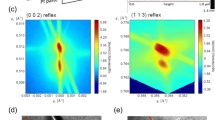Abstract
The electrical conduction of a high-resistance SrTiO3 crystal due to the presence of conductive nanowires in the bulk of the sample exhibits an unsteady-state behavior, which, in particular, manifests itself in a long-term decrease of the electric current at a fixed value of the applied voltage. This process, as well as the recovery of the initial conduction, is characterized by a wide range of times from several tens of seconds to ten days. It has been found that a decrease in the electric current is associated with a change of the electrical conductivity in the reverse-biased contact region most likely due to an increase in the height/width of the surface barrier. The modulation of the energy profile of the barrier can have a multidirectional character depending on the sign of the charge formed with the participation of surface states at the electrode–crystal interface. The results obtained have made it possible to elucidate the mechanism of charge transfer in local regions of the contact, where metallic nanowires penetrate deep enough into the depleted barrier layer.
Similar content being viewed by others
References
S. I. Shablaev and A. I. Grachev, Phys. Solid State 56 (4), 682 (2014).
S. I. Shablaev and A. I. Grachev, Phys. Solid State 57 (8), 1500 (2015).
S. I. Shablaev and A. I. Grachev, Phys. Solid State 58 (5), 933 (2016).
K. Szot, W. Speier, R. Carius, U. Zastrow, and W. Beyer, Phys. Rev. Lett. 88, 75508 (2002).
K. Szot, W. Speier, G. Bihlmayer, and R. Waser, Nat. Mater. 5, 312 (2006).
R. Waser, R. Dittmann, G. Staikov, and K. Szot, Adv. Mater. (Weinheim) 21, 2632 (2009).
R. Muenstermann, T. Menke, R. Dittmann, and R. Waser, Adv. Mater. (Weinheim) 22, 4819 (2010).
R. Waser and M. Klee, Integr. Ferroelectr. 2, 257 (1992).
C. Ni, S. M. Guo, H. F. Tian, Y. G. Zhao, and J. Q. Li, Appl. Phys. Lett. 91, 183502 (2007).
H.-J. Zhang, X- P. Zhang, and Y.-G. Zhao, Chin. Phys. Lett. 26, 077303 (2009).
X. B. Yan, K. Li, J. Yin, Y. D. Xia, H. X. Guo, L. Chen, and Z. G. Liua, Electrochem. Solid-State Lett. 13, H87 (2010).
Z. B. Yan and J.-M. Liu, Sci. Rep. 3, 2482 (2014).
D. Kan and Y. Shimakawa, Appl. Phys. Lett. 103, 142910 (2013).
X-B. Yin, Z-H. Tan, and X. Guo, Phys. Chem. Chem. Phys 17, 134 (2015).
E. Mikheev, B. D. Hoskins, D. B. Strukov, and S. Stemmer, Nat. Commun. 5, 3990 (2014).
E. Mikheev, J. Hwang, A. P. Kajdos, A. J. Hauser, and S. Stemmer, Sci. Rep. 5, 11079 (2015).
C. Sudhama, A. C. Campbell, P. D. Maniar, R. E. Jones, R. Moazzami, C. J. Mogab, and J. C. Lee, J. Appl. Phys. 75, 1014 (1994).
S.-G. Yoon, A. I. Kingon, and S.-H. Kim, J. Appl. Phys. 88, 6690 (2000).
B. Nagaraj, S. Aggarwal, and R. Ramesh, J. Appl. Phys. 90, 375 (2001).
I. Stolichnov and A. Tagantsev, J. Appl. Phys. 84, 3216 (1998).
E. H. Rhoderick, Metal–Semiconductor Contacts (Clarendon, Oxford, 1978; Radio i Svyaz’, Moscow, 1982).
G. D. J. Smit, S. Rogge, and T. M. Klapwijk, Appl. Phys. Lett. 81, 3852 (2002).
J. Hou, S. S. Nonnenmann, W. Qin, and D. A. Bonnell, Adv. Funct. Mater. 24, 4113 (2014).
Y. B. Zhu and L. K. Ang, Sci. Rep. 5, 9173 (2015).
B. K. Readly, Proc. Phys. Soc. 82, 954 (1963).
A. Thanailakis and D. C. Northop, J. Phys. D: Appl. Phys. 4, 1776 (1971).
E. M. Bourim, Y. Kim, and D.-W. Kim, ECS J. Solid State Sci. Technol. 3 (7), N95 (2014).
Author information
Authors and Affiliations
Corresponding author
Additional information
Original Russian Text © S.I. Shablaev, A.I. Grachev, 2016, published in Fizika Tverdogo Tela, 2016, Vol. 58, No. 10, pp. 1890–1894.
Rights and permissions
About this article
Cite this article
Shablaev, S.I., Grachev, A.I. Effect of unsteady-state conduction of a high-resistance SrTiO3 crystal containing a network of conductive nanowires. Phys. Solid State 58, 1956–1961 (2016). https://doi.org/10.1134/S1063783416100322
Received:
Published:
Issue Date:
DOI: https://doi.org/10.1134/S1063783416100322




